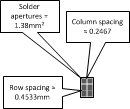I have a customer who needs some guidance on the solder paste requirements for the TAS5766M. In particular, do we recommend 50% minimum solder paste coverage over the exposed pad? Their manufacturing arm is referencing SLUA271A (http://www.ti.com/lit/an/slua271a/slua271a.pdf ) to justify 50% coverage. SLUA271A states:
Typically, the solder-paste coverage is approximately 50% to 70% of the pad area (see Figure 11).
Designing an aperture that prints solder 1:1 with the exposed pad results in excessive metal volume that
will “float” the part, causing opens and other manufacturing defects. In addition, the amount of voiding post
reflow in the thermal pad solder joint should not exceed 50% in high power applications (to be verified
using an x-ray). Based on a JEDEC High K board stackup, 25% has been determined to be a point of
diminishing thermal performance returns, but TI prefers a limit of 50% to be set (reference JESD51-7).
First, is this application note applicable to the TAS5766M QFN package which is substantially bigger.
Second, its unclear what 50% - 70% would realistically look like. I have some confidential pics I can show offline.
Please let me know who I can talk to about this ASAP bec they are in the process of building this up now!
Thanks, John Garrett, TI-AFA


